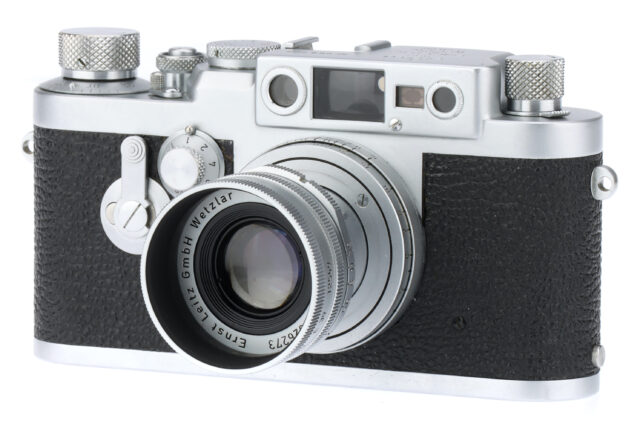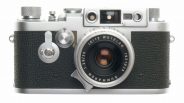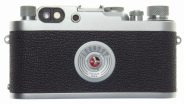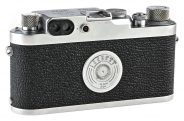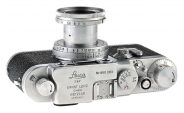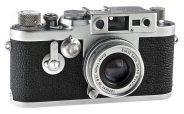Announced
Production status
Order No.
System
Leica SM system cameras
- Leica ‘Prototype 2’ Replica with Anastigmat 50mm F/3.5
- Leica 0-Serie Replica with Anastigmat 50mm F/3.5
- Leica I (Model A)
- Leica I (Model B)
- Leica I (Model C)
- Leica Ic
- Leica If
- Leica Ig
- Leica II (Model D)
- Leica IIc
- Leica IIf
- Leica III (Model F)
- Leica IIIa (Model G)
- Leica IIIb (Model G)
- Leica IIIc
- Leica IIId
- Leica IIIf
- Leica IIIg
- Leica Standard (Model E)
- Leica "72"
- Ur-Leica
Leica IIIg
35mm MF film rangefinder camera • Discontinued
Specification
| Format: | |
| 35mm full frame | |
Film type: | 135 cartridge-loaded film |
| Leica screw mount [28.8mm] | |
| Shutter: | |
Type: | Focal-plane |
Model: | Mechanical |
Speeds: | 1 - 1/1000 + B |
| Exposure: | |
Exposure metering: | None |
Exposure modes: | Manual |
| Rangefinder and Viewfinder: | |
Rangefinder: | Built-in |
Viewfinder: | Built-in |
Finder magnification: | 1.5x |
Actual rangefinder base: | 39mm |
Effective rangefinder base: | 58.5mm |
Bright-line frames: | 50mm, 90mm |
Parallax compensation: | Yes |
| Physical characteristics: | |
Weight: | 460g |
Dimensions: | <No data> |
| Accessories: | |
Body cap: | 14055 |
| LOPEN / 35355 | |
| ORTVO / ORTVOCHROM / 66870 |
Manufacturer description #1
From the LEICA photography magazine (1957, No. 1):
IIIg... newest of the classic Leicas
redesigned viewfinder heads list of improvements
Each new Leica model, with the exception of the Leica M-3, has been an evolutionary step from the original and, by now, classic design of Oskar Barnack. Only when Leitz designers have been sure that changes would contribute to the final goal of better pictures, has the camera been altered. With this in mind, the announcement of the new Leica IIIg (replacing the IIIf) is an exciting event.
new viewfinder
The biggest advance in the IIIg is its new viewfinder. The large (.7x lifesize) image has superimposed on it a bright-line frame outlining the field of 50mm lenses. Within the 50mm field, four bright triangles show the corners of the field of 90mm lenses. Incorporated in the new viewfinder is automatic parallax correction through the entire focusing range of the lenses for both 50mm and 90mm frame indicators.
Another feature of the new viewfinder is its freedom from "eye parallax." That is, if you do not look directly through the center of the finder when shooting fast, for example, you will still frame accurately.
As in the IIIf, the rangefinder of the new IIIg is separate from the viewfinder, but its eyepiece is located right next to the viewfinder eyepiece. The rangefinder image is magnified 1.5x for critical accuracy in focusing. The rangefinder optics can be focused on near or distant objects as well as be accommodated to your own individual eyesight.
automatic flash synchronization
An outstanding addition to the IIIg is its automatic flash synchronization. Like the M-3, it needs no special synchro-dial setting to change the "synch" timing when you change shutter speeds. When you reset the shutter speed the flash contact points are reset automatically for proper synchronization.
shutter speeds
Shutter speeds on the IIIg are designed to correlate exactly with diaphragm settings; each step, up or down, gives one-half or twice the exposure, as does each step on the aperture scale.
The fast-speed dial on top of the camera gives speeds of 1/1000, 1/500, 1/250, 1/125, 1/60, 1/30 second and "Bulb." The slow speed dial, on the front of the camera, gives 1/30, 1/15, 1/8, 1/4, 1/2, 1 second and "Time."
lenses
The new IIIg has the same standard threaded lens flange as the IIIf and previous Leicas with interchangeable lenses. The same lenses now available for such Leicas will be supplied for the new camera. A new screw-mounting 50mm Elmar f/2.8 lens will be available soon in limited quantities.
electronic flash
On the fast-speed dial there are two extra shutter settings marked in red and black for use with zero-delay electronic flash units or five-millisecond delay bulbs such as the SF and M2. These markings are located next to the 1/60th and 1/30th settings. Both may be used for electronic flash; five-millisecond delay bulbs work only at red arrow setting next to 1/ 30th.
film exposure index reminder
The film exposure index reminder has been moved from the winding knob to the back of the IIIg housing. It is calibrated for both ASA and DIN ratings, and can be set as high as 1000 ASA. The winding knob and self-timer, rewind knob and exposure counter are the same on the IIIg as on the IIIf.
In overall looks, the IIIg is quite similar to the IIIf. However, the top section of the body is somewhat higher in the IIIg. The Leicavit rapid winder fits the IIIg without alteration. Close-up devices like the SOOKY and Focoslide will be available for the IIIg later in the year.
There will not be a model IIg to replace the discontinued IIf camera, but production of the If will continue. No conversion of previous screw-threaded Leica models to a IIIg is possible.
Price of the IIIg with collapsible 50mm Summicron f/2 lens is $342.00. With a 50mm Elmar f/3.5 lens, the price is $244.50.
Manufacturer description #2
February 15, 1957:
We are pleased to announce a number of important new products - including a new Leica IIIg Camera, a new f/2.8 50mm Elmar Lens, and various other items.
LEICA IIIg CAMERA
Since the introduction of the Leica M 3, the most advanced of all Leica models, Leitz engineers have been at work to improve the IIIf, the classic Oskar Barnack Leica design. This new camera is now here and the improvements are so important that it has been given a new designation: "IIIg". The more important improvements are outlined below.
a) Improved Viewfinder
The viewfinder is of the bright-line type, similar to the viewfinder of the M 3, giving a larger image than the IIIf finder and offering freedom from eye parallax. The corners of the 90mm frame are also indicated by bright triangles, which eliminate the necessity of an auxiliary viewfinder for the 90mm lens. While the eyepieces of view- and rangefinder are still separated, it is easier to shift from one to the other than it was with previous models.
b) Automatic Parallax Correction
The bright-line frame of the viewfinder is connected with the focusing mechanism and moves so that there is always complete correction for parallax within the entire focusing range of the lens.
c) Automatic Flash Synchronization Adjustment
The synchro dial has been eliminated. Changing shutter speeds automatically resets the built-in synchronizer for flash bulb photography. Special shutter speed settings are provided for electronic flash.
d) Geometric Shutter Speeds are arranged to follow a logical progression in which each speed gives twice as much exposure as the next faster shutter speed: 1/1000, 1/500, 1/250, 1/125, 1/60, 1/30, 1/15, 1/8, 1/4, 1/2, 1.
e) The Method of Changing Lenses is the same as on the IIIf. The IIIg accepts all screw-in type Leica lenses.
There are numerous other refinements in the IIIg such as the film indicator on the back similar to that on the M 3 and other items which you will recognize when you see and handle this new camera.
Manufacturer description #3
The Leica lIIg has many features which give it outstanding performance. Its shutter speeds run from 1 second to 1/1000th second, "Time" and "Bulb". They are in geometric sequence - each gives half or double the exposure time of the one next to it on the dial. This correlates with the aperture stops, since each stop admits half or twice the light of the stop next to it.
The bright-line frame viewfinder of the lIIg shows the field of 50mm lenses. Within the 50mm field, four bright "corners" mark the field of 90mm lenses. Parallax compensation for both fields is automatic throughout the entire normal focusing range of lenses. The built-in range-finder couples automatically to the lenses and magnifies the image 1.5X for extreme accuracy in focusing. Its eyepiece is alongside the viewfinder eyepiece in a twin mount.
As in the M 3 and M 2, flash synchronization for both electronic units and flash bulbs is automatic in the lIIg. There are no dial settings to make. When you set the shutter speed, synchronization is set automatically.
All screw-mounting lenses available for previous Leica models will fit the IIlg; many accessories, including the famous Leicavit Rapid Winder are available for it. However, earlier models of the Leica cannot be converted into the IIlg.
Manufacturer description #4
Body with carrying strap eyelets, hard rubber covering bonded to camera housing, and chromium-plated metal parts; built-in bright-line frame finder for both 50 mm and 90 mm lenses, with automatic parallax compensation for both focal lengths; automatic flash synchronization for conventional and electronic flash units (X and M); lens-coupled, coincident-type rangefinder with 1.5 x magnification, focal plane shutter with speeds from 1 second to 1/1000 second, T and B; built-in self-timer; simultaneous shutter wind, film advance and exposure counter; accessory clip; screw-threaded lens mount.
Manufacturer description #5
The LEICA III g differs from the LEICA III f in the following technical features:
- Large bright-line viewfinder with automatic parallax compensation.
- Shutter speeds graduated in geometric progression.
- Fully automatic synchronization (without contact numbers).
- Film indicator in the back of the camera body.
Serial No. from 825001.
Manufacturer description #6
FROM IIIf to IIIg...
ANOTHER STEP AHEAD FOR THE CLASSIC
Here is the latest design of the camera that is the core of the classic LEICA system. The IIIg improves and perpetuates the precision camera long famous for the greatest variety and versatility in 35mm photography.
improved viewfinder vision: larger, clearer image, with brightline frame for the 50mm lens field and luminous corners indicating the 90mm lens field - both with automatic parallax correction through the entire focusing range.
automatic synchronization, for standard or electronic flash, adjusts when shutter speeds are set.
improved rangefinder visibility is an outstanding feature of the IIIg rangefinder optical system of 1.5x magnification. This system adjusts for critical focusing and individual vision with greater ease than before.
other famous LEICA features: Full-range focal-plane shutter, 1 sec. to 1/1000 sec., T and B, calibrated to correlate with f-stops. Screw-mount interchangeability for over 12 different lenses. Compactness, light weight, easy operation. Plus the "little" things that count: film reminder dial, built-in self timer, accessory clip, "soft-action" release button. Leicavit, rapid winder for sequence photography, replaces the baseplate, is available as an accessory.
From the editor
The last and the best of Leica's screw mount cameras. Also one of the most sophisticated.
About 41,583 units were made from 1957 to 1961, and in 1970.
Similar cameras (63)
35mm full frame • Manual focus • Film • Rangefinder • Leica screw mount mount
| Model | Shutter | Metering | Modes | Year |
|---|---|---|---|---|
| Canon 7 | M, 1/1000 | Window | M | 1961 ● |
| Canon 7s | M, 1/1000 | Window | M | 1965 ● |
| Canon II-A | M, 1/1000 | -- | M | 1952 ● |
| Canon II-AF | M, 1/500 | -- | M | 1953 ● |
| Canon II-AX | M, 1/500 | -- | M | 1953 ● |
| Canon II-B | M, 1/500 | -- | M | 1949 ● |
| Canon II-C | M, 1/500 | -- | M | 1950 ● |
| Canon II-D | M, 1/500 | -- | M | 1952 ● |
| Canon II-D1 | M, 1/500 | -- | M | 1952 ● |
| Canon II-D2 | M, 1/500 | -- | M | 1955 ● |
| Canon II-F | M, 1/500 | -- | M | 1953 ● |
| Canon II-F2 | M, 1/500 | -- | M | 1955 ● |
| Canon II-S | M, 1/500 | -- | M | 1954 ● |
| Canon II-S2 | M, 1/500 | -- | M | 1955 ● |
| Canon III | M, 1/1000 | -- | M | 1951 ● |
| Canon III-A | M, 1/1000 | -- | M | 1951 ● |
| Canon IV | M, 1/1000 | -- | M | 1951 ● |
| Canon IV-F (IV-S) | M, 1/1000 | -- | M | 1952 ● |
| Canon IV-SB | M, 1/1000 | -- | M | 1952 ● |
| Canon IV-SB2 | M, 1/500 | -- | M | 1954 ● |
| Canon L1 | M, 1/1000 | -- | M | 1957 ● |
| Canon L2 | M, 1/500 | -- | M | 1957 ● |
| Canon L3 | M, 1/500 | -- | M | 1957 ● |
| Canon P | M, 1/1000 | -- | M | 1959 ● |
| Canon VI-L | M, 1/1000 | -- | M | 1958 ● |
| Canon VI-T | M, 1/1000 | -- | M | 1958 ● |
| Canon VL | M, 1/1000 | -- | M | 1958 ● |
| Canon VL2 | M, 1/500 | -- | M | 1958 ● |
| Canon VT | M, 1/1000 | -- | M | 1956 ● |
| Canon VT de luxe | M, 1/1000 | -- | M | 1957 ● |
| Cosina Voigtlander BESSA-R | M, 1/2000 | TTL • WA | M | 2000 ● |
| Drug aka Друг |
M, 1/1000 | -- | M | 1960 ● |
| FED aka ФЭД |
M, 1/500 | -- | M | 1934 ● |
| FED-2 aka ФЭД-2 |
M, 1/500 | -- | M | 1955 ● |
| FED-2L aka ФЭД-2Л |
M, 1/500 | -- | M | 1969 ● |
| FED-3 aka ФЭД-3 |
M, 1/500 | -- | M | 1961 ● |
| FED-4[K] aka ФЭД-4[К] |
M, 1/500 | Window | M | 1964 ● |
| FED-5 aka ФЭД-5 |
M, 1/500 | Window | M | 1977 ● |
| FED-5S aka ФЭД-5с |
M, 1/500 | Window | M | 1977 ● |
| FED-5V aka ФЭД-5в |
M, 1/500 | -- | M | 1975 ● |
| Leningrad | M, 1/1000 | -- | M | 1956 ● |
| Minolta-35 Model A | M, 1/500 | -- | M | 1947 ● |
| Minolta-35 Model B | M, 1/500 | -- | M | 1947 ● |
| Minolta-35 Model C | M, 1/500 | -- | M | 1948 ● |
| Minolta-35 Model D | M, 1/500 | -- | M | 1949 ● |
| Minolta-35 Model E | M, 1/500 | -- | M | 1951 ● |
| Minolta-35 Model F | M, 1/500 | -- | M | 1952 ● |
| Minolta-35 Model II | M, 1/500 | -- | M | 1953 ● |
| Minolta-35 Model IIB | M, 1/500 | -- | M | 1958 ● |
| Mir aka Мир |
M, 1/500 | -- | M | 1959 ● |
| Yashica YE | M, 1/500 | -- | M | 1959 ● |
| Yashica YF | M, 1/1000 | -- | M | 1959 ● |
| Zorki aka Зоркий aka ФЭД aka ФЭД 1948 Зоркий aka ФЭД 1949 Зоркий |
M, 1/500 | -- | M | 1948 ● |
| Zorki-2 aka Зоркий-2 |
M, 1/500 | -- | M | 1954 ● |
| Zorki-2S aka Зоркий-2С |
M, 1/500 | -- | M | 1955 ● |
| Zorki-3 aka Зоркий-3 |
M, 1/1000 | -- | M | 1951 ● |
| Zorki-3M aka Зоркий-3М |
M, 1/1000 | -- | M | 1954 ● |
| Zorki-3S aka Зоркий-3С |
M, 1/1000 | -- | M | 1955 ● |
| Zorki-4 aka Зоркий-4 |
M, 1/1000 | -- | M | 1956 ● |
| Zorki-4K aka Зоркий-4К |
M, 1/1000 | -- | M | 1972 ● |
| Zorki-5 aka Зоркий-5 |
M, 1/500 | -- | M | 1958 ● |
| Zorki-6 aka Зоркий-6 |
M, 1/500 | -- | M | 1959 ● |
| Zorki-S aka Зоркий-С |
M, 1/500 | -- | M | 1955 ● |
